Massive stellar clusters contribute to the majority of star light and play an important role of galactic ecosystem. However, their formation process remain unclear. The process is time dependent and therefore dynamic over a million years, while observations offer only a series of snapshots of the entire lifetime. The new generations of facilities, especially the Atacama Large Millimeter/submillimeter Array (ALMA) in Chile, enable scientists to retrospect the baby stage of massive stellar clusters, namely massive protostellar clusters, and witness how they grow in great detail.
Combining ALMA observations and single-dish observations including Atacama Pathfinder Experiment telescope (APEX) in Chile and James Clerk Maxwell Telescope (JCMT) in Hawaii, Fengwei Xu, a fourth-year Ph.D. student under the supervision of Prof. Ke Wang at the Kavli Institute for Astronomy and Astrophysics at Peking University, proposed a comprehensive evolutionary picture of how massive protoclusters are assembled. The series of works have been accepted for publication by Monthly Notice of the Royal Astronomical Society and The Astrophysical Journal Supplement Series.
Eleven massive infrared bright clumps were chosen as the pilot sample in an ongoing project called ALMA Survey of Star Formation and Evolution in Massive Protoclusters with Blue Profiles (ASSEMBLE). These clumps are thought to harbor massive protoclusters in a late stage. As a comparison, 12 massive infrared dark clumps were retrieved as the early version of ASSEMBLE, from another project called ALMA Survey of 70-um Dark High-mass Clumps in Early Stages (ASHES). “We’re excited to find two surveys with highly consistent angular resolution, sensitivity, and field of view,” said Fengwei Xu, the first author of the paper, “they’re the best for comparative studies.”
High-density structures inside massive clumps are called dense cores, which are the cradle of stars. The team made a census of 248 dense cores and found that late-stage ASSEMBLE protoclusters show systematic increase in dense core mass and surface density compared to the early-stage ASHES protoclusters. They also found a clear correlation in the ASSEMBLE sample, between the clump mass and the most massive core mass, but not seen in the ASHES sample (see Figure 1), which indicates a co-evolution regulated by continuous mass accretion from clump to core scale.

Figure 1. The scaling relation between the masses of clumps and the most massive cores in each clump. The fitting results are shown on the top left. The shaded area shows the fitting uncertainty of the ASSEMBLE sample.
The team discovered that the dense cores in the ASSEMBLE protoclusters exhibit significantly closer proximity compared to those in the ASHES protoclusters (see Figure 2). As shown in the right panel, the Q parameter, which gauges how a cluster is centrally concentrated, shows a marginal increase with evolutionary stage traced by luminosity-to-mass ratio. These findings align with the predictions of a theoretical dynamic model where dense cores are driven inwards by gravitational potential of parent massive clump. This model anticipates rapid mass accretion on the clump scale, exactly as viewed from the APEX HCN (4-3) and CO (4-3) line survey, led by Prof. Tie Liu at Shanghai Astronomical Observatory, who is also the P.I. of the ASSEMBLE ALMA observations.
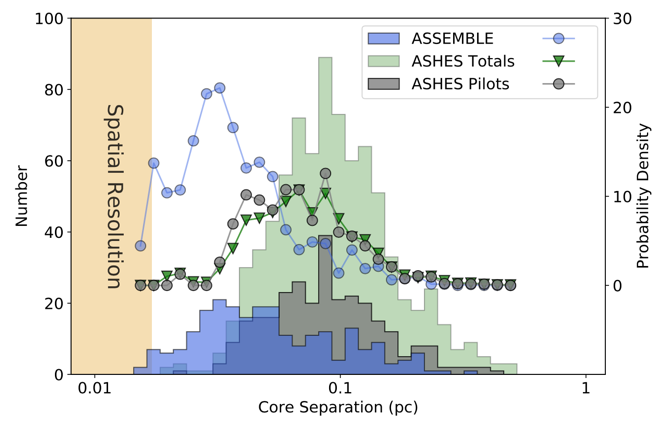

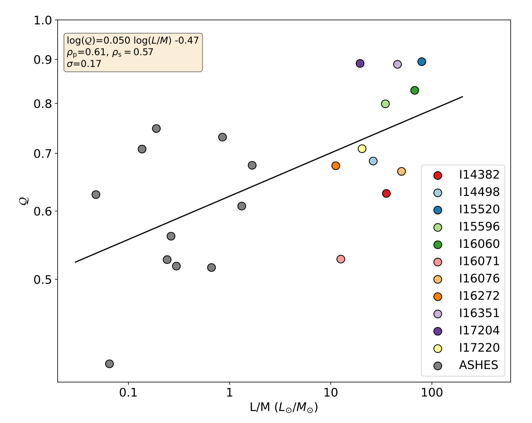
Figure 2. Left: the number distribution and probability density distribution of core separations of ASSEMBLE and ASHES samples. The spatial resolutions of 0.02 pc are labelled in yellow shaded area. Right: Q parameters versus luminosity-to-mass ratio. The linear regression results are shown on the upper left.
Mass segregation is commonly found in dynamically old star clusters as a result of energy equipartition through two-body interactions. Yet, the debate persists as to whether the mass segregation is purely a dynamical effect or if it is inherited from the primordial protoclusters. Only a limited number of research teams have sought to discover so-called “primordial mass segregation” and their efforts have been hampered either by insufficient spatial resolution or small sample size. Very recently, the ASHES team have reported no discernible primordial mass segregation in the initial stage of massive star cluster formation. However, Xu et al. reported that a significant number of the ASSEMBLE protoclusters exhibit evident mass segregation (see Figure 3). More interestingly, such dynamic evolution of mass segregation, observed from early-stage ASHES to late-stage ASSEMBLE, cannot be explained by a pure dynamical effect since the dynamical relaxation timescale of the system is far longer than the lifetime of these protoclusters. In contrast, the observed mass segregation aligns well with the “competitive accretion” model where cores tend to accumulate more mass within deeper gravitational potentials.
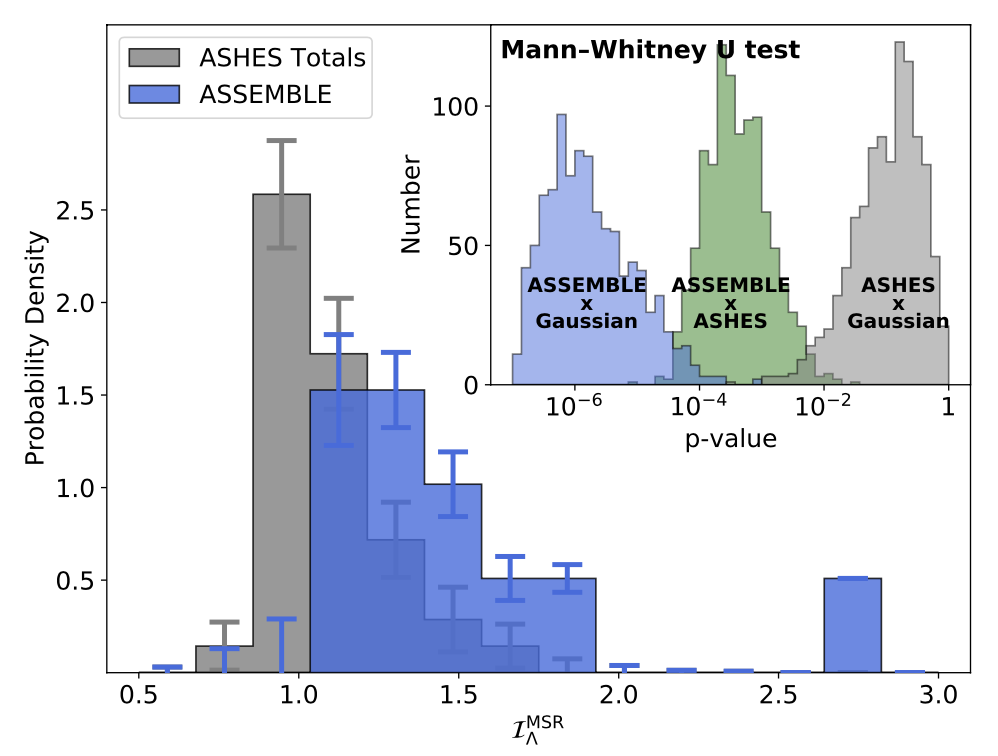
Figure 3. The probability density distribution of mass segregation integrals of the ASHES (gray) and ASSEMBLE (blue). The p-values of the statistical test between ASSEMBLE, ASHES, and Gaussian noise are shown in the upper right corner.
Concluding the results above, Xu et al. propose a comprehensive dynamic perspective on massive protocluster evolution (Figure 4). At the initial stage, the protocluster originates from thermal Jeans fragmentation, with wide separation and no mass segregation. Subsequently, filamentary structure act as “conveying belts” and facilitate mass transfer towards the cores, by which the connection between the clump and core is gradually established. Concurrently, protostars form from dense cores, leading to the heating of gas and dust, clump transitioning into infrared weak state. Due to the effects of persistent global gravitational collapse and contraction, the protocluster becomes even tighter with narrower core separations and the mass segregation builds up in the late stage.
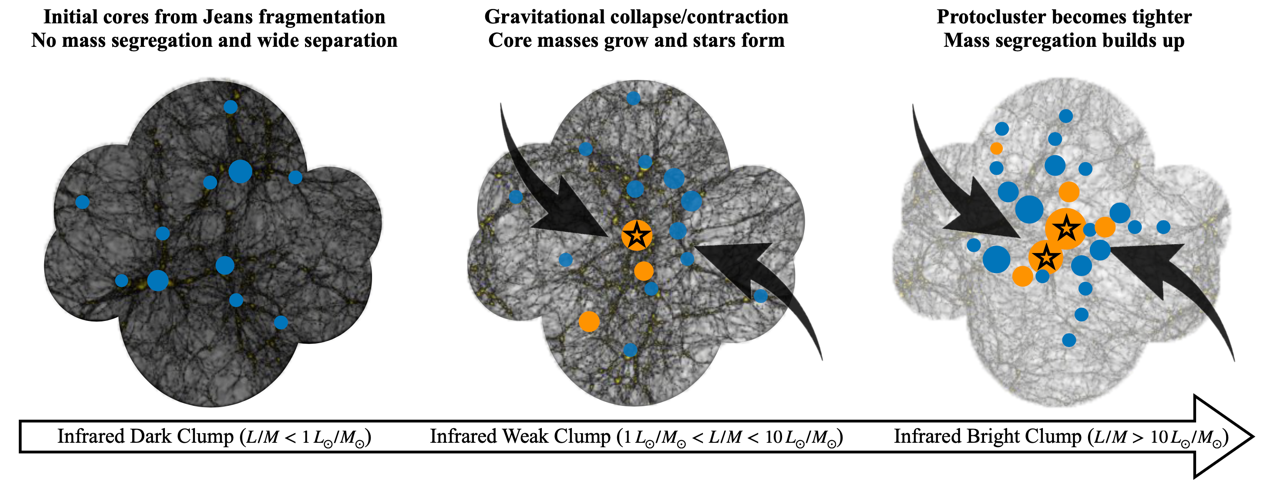
Figure 4. The evolutionary picture of massive protocluster evolution, from infrared dark (left), to infrared weak (mid), and to infrared bright (right). The blue circles indicate the dense cores without protostars and the orange circles indicate ones with protostars. The black stars indicate OB stars. The black arrows indicate gas infall motion.
The dynamic scenario becomes more complete when another independent research has been published, focusing on the gas kinematics along the filamentary structure inside a massive star-forming clump SDC335 (see Figure 5). “This guy is really the best laboratory to study gas kinematics and we’re lucky to have the ALMA data,” said Fengwei, “the spiral-like streamers connect multiple scales, continuously conveying material into protostars as predicted by the theory.”
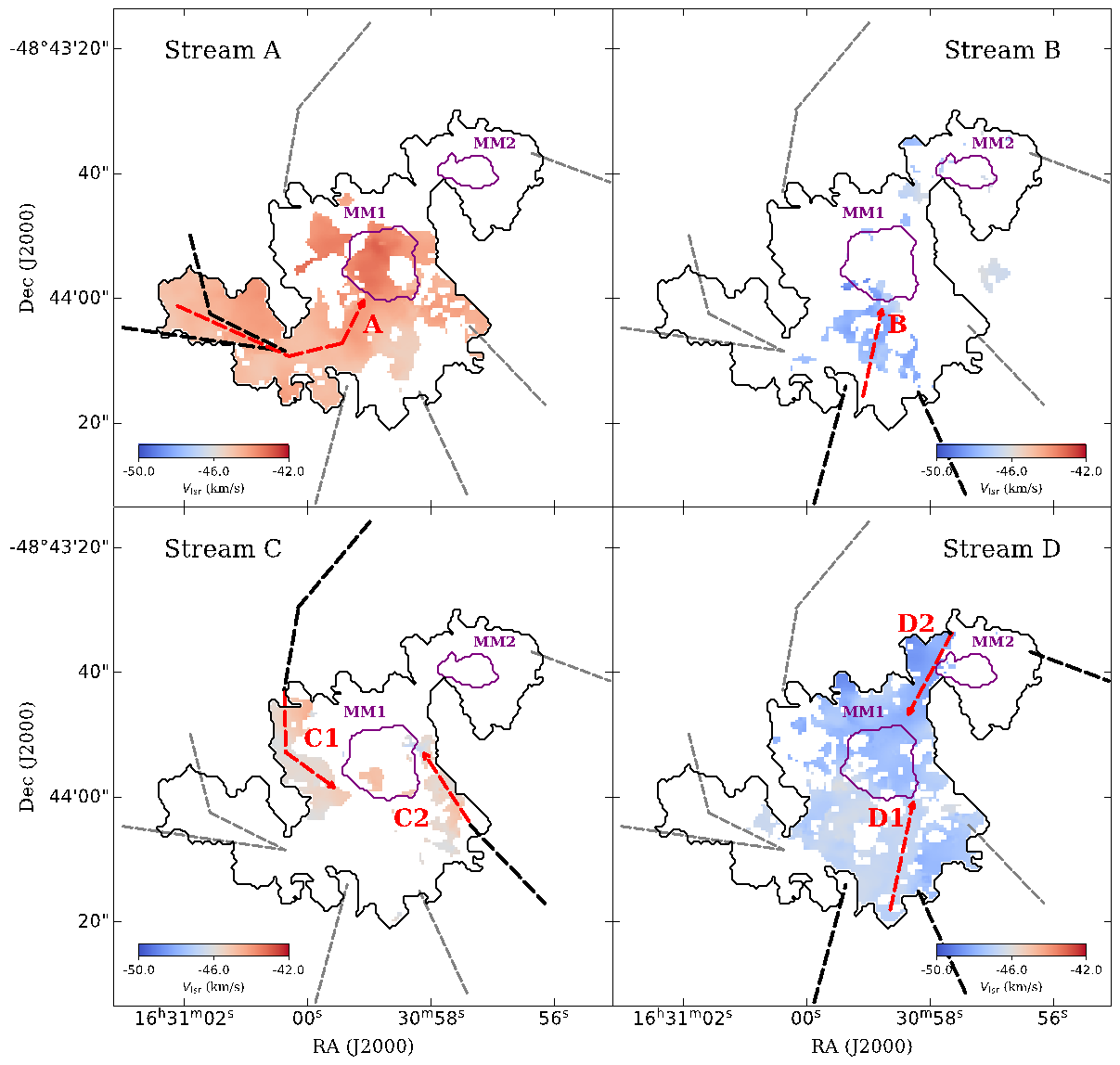
Figure 5. Gas kinematics in the massive star-forming region SDC335. The color scale indicates the velocity of H13CO+ (J=1-0) gas. Four streamers A—D identified by red dashed arrows are the gravity-driven gas flows towards the clump center.
This story is to be continued. In the next episode, the team expand the sample in the Northern sky by the JCMT HCN (4-3) line survey. Their results are represented in another paper published by The Astrophysical Journal Supplement Series. “The HCN (4-3) line with high critical density can serve as the golden tracer of the core-scale gas infall.” said Prof. Ke Wang. From more than 6000 massive star-forming clump candidates, Xu et al. finally identified 11 most promising global collapsing clumps (an example shown in Figure 6), which calls for further high angular resolution observations just as it’s done in the pilot ASSEMBLE sample.

Figure 6. BG081.721+00.572 also called DR21(OH), an example of massive star-forming clumps with global collapse. The background colormap and contours show the Herschel 250 um emission, overlaid with JCMT HCN (4-3) spectra. The coherent blue-shift asymmetric profiles indicate the clump is undergoing gas infall.
Reference:
https://iopscience.iop.org/article/10.3847/1538-4365/acfee5
https://iopscience.iop.org/article/10.3847/1538-4365/acfee2
https://academic.oup.com/mnras/article/520/3/3259/7040271